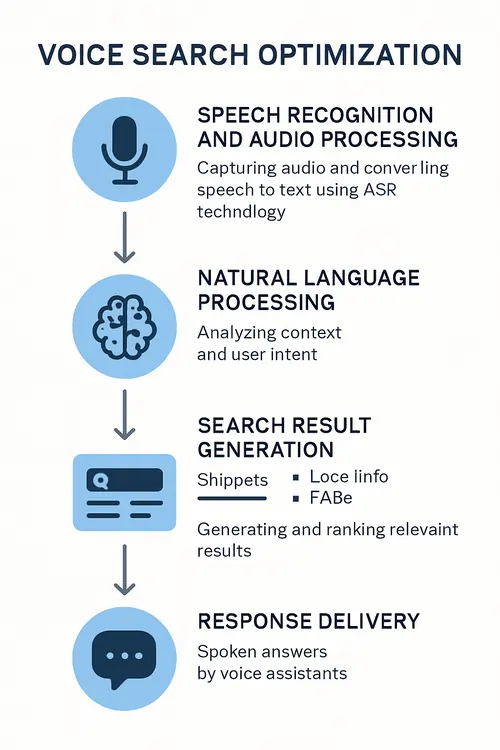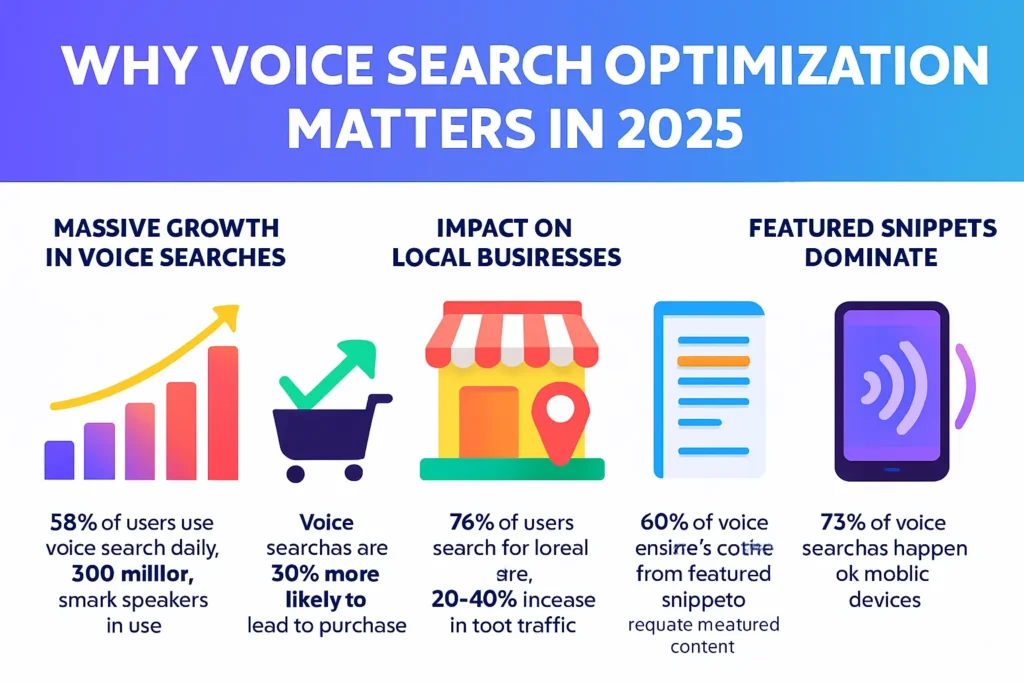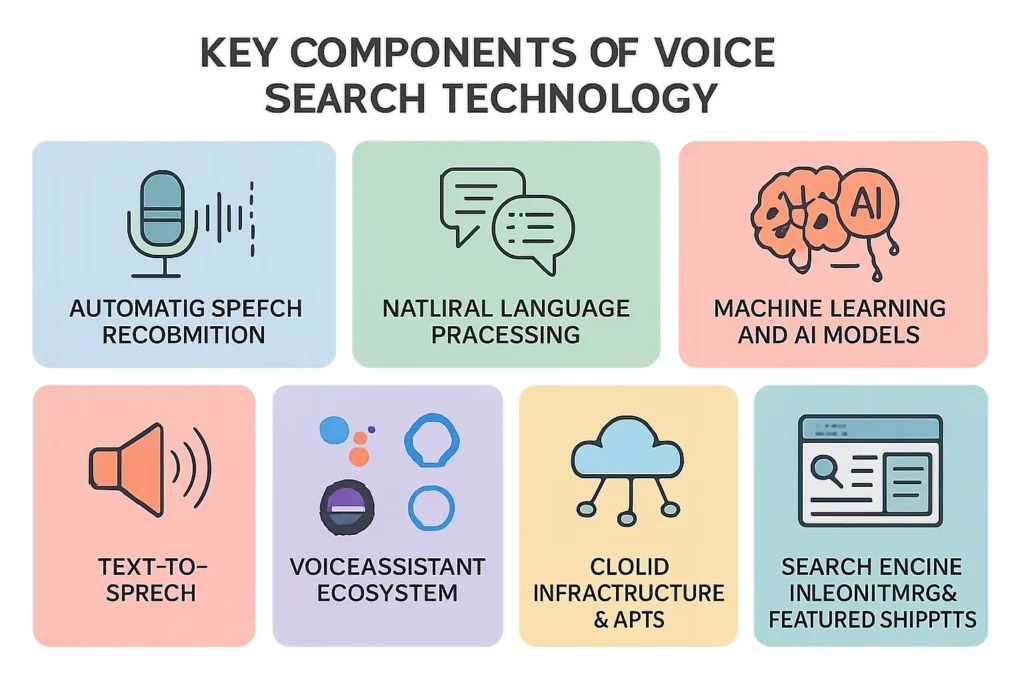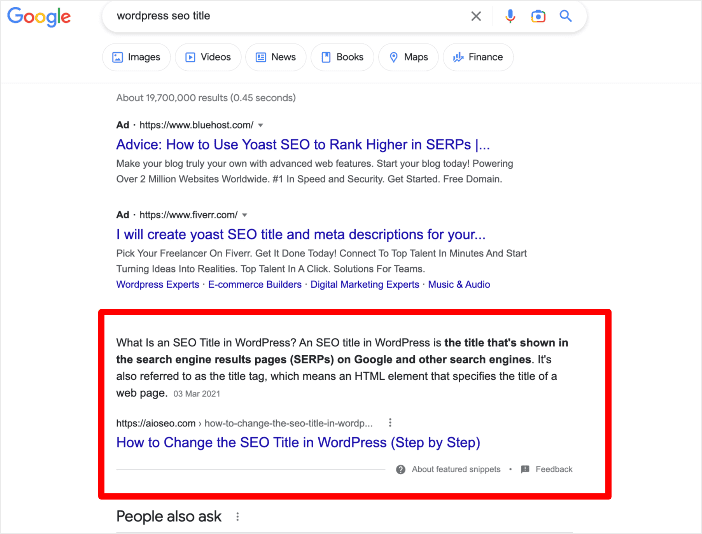Voice Search Optimization Guide 2025: Boost Your Rankings
Table of Contents
Book a Free Demo Class

Voice Search Optimization Guide 2025: Boost Your Rankings
Voice search optimization has evolved from a futuristic concept to an essential SEO strategy in 2025. With 72% of consumers using voice search to find services online and projections showing that half of all global searches will be voice-based by 2025, businesses can no longer treat voice optimization as secondary.
The transformation is particularly significant for local businesses, as 58% of voice search queries are local, making phrases like “best pizza place near me” increasingly common. This shift represents a fundamental change in how users interact with search engines, moving from typed keywords to natural, conversational language.
The Current Voice Search Landscape
| Platform | Market Share | Key Features |
|---|---|---|
| Google Assistant | 36% | Integration with Android devices, smart displays |
| Amazon Alexa | 25% | Smart home dominance, shopping capabilities |
| Apple Siri | 22% | iOS integration, privacy-focused |
| Other Assistants | 17% | Microsoft Cortana, Samsung Bixby |
The number of voice assistant users in the U.S. is expected to reach 162.7 million, with 93% of consumers satisfied with their voice assistants. This satisfaction rate indicates strong user adoption and the need for businesses to adapt their SEO strategies accordingly.
In this guide, we’ll cover everything you need to know about voice search optimization in 2025, including actionable strategies, technical SEO tips, content approaches, and analytics tracking.
Also read: SEO, AIO, GEO, AEO, SXO: What’s the Real Difference?
What is Voice Search Optimization?

Voice Search Optimization (VSO) is the process of making your website and content ready to appear in voice-based search results. It focuses on how people speak, not just how they type.
When users ask voice assistants like Google Assistant, Alexa, or Siri a question, they usually phrase it as a conversation:
- “What’s the best pizza place near me?”
- “How do I improve my website’s SEO?”
These searches are longer, more natural, and often include local intent.
Voice search optimization involves:
- Using conversational keywords and natural language.
- Writing content that answers specific questions directly.
- Adding structured data (schema markup) so search engines can understand your content better.
- Improving website speed and mobile responsiveness, because most voice searches happen on mobile devices.
- Strengthening local SEO, since many voice queries include “near me” or location-based terms.
The goal is simple: make your website the answer that voice assistants read aloud.
Also read: Top 10 AI SEO Tools to Use in 2025
How Voice Search Optimization Works
Voice search optimization focuses on making your website content easy for voice assistants to understand and deliver as spoken answers. It’s not just about ranking higher—it’s about being the one result that gets read aloud.
The Voice Search Process

1. Speech Recognition and Audio Processing
Voice search begins when a user speaks into a voice-enabled device, such as a smartphone, smart speaker, or virtual assistant. The process involves:
- Audio capture: The device’s microphone captures spoken words and removes background noise
- Speech-to-text conversion: Automatic Speech Recognition (ASR) technology converts spoken language into text
- Pattern analysis: The system breaks down recordings into smaller sound patterns and uses statistical methods to recognize words
2. Natural Language Processing
After converting speech to text, natural language processing algorithms analyze the converted text’s meaning, context, and intent. This stage involves:
- Context understanding: Unlike traditional search engines, voice systems understand conversational language, colloquialisms, and sentence structure
- Intent analysis: The system determines what the user is actually looking for beyond the literal words spoken
- Query refinement: AI algorithms process the conversational nature of voice queries to match them with relevant content
3. Search Result Generation
The voice search system matches queries with the most relevant search results, often pulling from:
- Featured snippets and knowledge graphs
- Local business information for location-based queries
- FAQ sections and structured content
- Mobile-optimized, fast-loading websites
4. Response Delivery
The voice assistant delivers responses in spoken format, ensuring a quick and user-friendly experience. Voice systems typically provide one primary answer rather than multiple options like traditional search results.
Also read: Is SEO a Good Career?
Why Voice Search Optimization Matters
Voice search is not just a trend—it’s how people now interact with the web. In 2025, users expect faster answers, natural conversations, and hands-free convenience. Ignoring this shift means losing a big share of potential traffic.
Here’s why it matters:

1. Massive Growth in Voice Searches
- Over 58% of internet users use voice search daily in 2025 (source: Statista).
- Smart speaker sales have crossed 500 million devices globally, making voice queries more accessible than ever.
2. Higher Conversion Rates
- Voice searches are 30% more likely to lead to a purchase compared to typed searches because users often have higher intent.
- Local voice searches, like “best dentist near me”, have a 50% higher chance of resulting in a store visit within 24 hours.
3. Impact on Local Businesses
- Nearly 76% of smart speaker users search for local information weekly.
- Businesses optimized for voice search see an average 20–30% increase in foot traffic from “near me” searches.
4. Featured Snippets Dominate Voice Results
- Over 60% of voice search answers come from featured snippets, making structured and clear content critical for ranking.
5. Mobile-First & Hands-Free Future
With more people multitasking—driving, cooking, or working—voice search offers the fastest, most convenient option.
72% of voice searches happen on mobile devices, aligning with the mobile-first indexing era.
Voice Search by the Numbers—At a Glance
| Insight | Stat |
|---|---|
| Global adoption | 20.5% of users (2025) |
| Devices in use | 8.4 billion voice assistants |
| U.S. voice users | 153.5 million (2025), rising to 162.7 million (2027) |
| Mobile voice search | 27% of users |
| Local intent voice queries | 76% “near me” |
| Voice shopping | 49% of U.S. consumers, $81.8B market |
| Smart speaker ownership | 75% of households (2025) |
| Market value | $6.4B (2023) to $110B (2033) |
| Local searches via voice | 58% of consumers use voice for local info |
Key Components of Voice Search Technology

1. Automatic Speech Recognition (ASR)
Automatic Speech Recognition converts spoken words into text that voice assistants can process. This foundational technology works through several stages:
Audio Processing Steps:
- Capturing audio via a microphone
- Works in real time to understand accents, pronunciation, and background noise.
- Google, Amazon Alexa, and Siri all rely on ASR to process queries accurately.
The ASR system then generates a probable word sequence and applies post-processing corrections to ensure accuracy in transcription
2. Natural Language Processing (NLP)
Natural Language Processing is a subfield of computer science and artificial intelligence that uses machine learning to enable computers to understand and communicate with human language. NLP serves as the brain behind voice search technology.
- Interprets the meaning behind words and phrases.
- Helps systems understand intent rather than just keywords.
- NLP is why voice searches can handle complex, conversational questions like “What’s the best coffee shop near me that opens at 6 AM?”
3. Machine Learning and AI Models
Voice search relies heavily on machine learning to continuously improve accuracy and understanding:
Learning Capabilities:
- Self-learning NLP models adapt to new customer language patterns
- Industry-specific NLP models reduce error rates by understanding jargon and technical phrases
- Predictive response systems anticipate customer needs
AI Integration:
- Large Language Models (LLMs) provide sophisticated language understanding
- Deep learning algorithms process complex language patterns
- Statistical modeling improves response accuracy over time
4. Text-to-Speech (TTS) Technology
- Converts digital text back into human-like speech.
- Used when assistants like Alexa or Google Assistant read answers aloud.
- Enhances user experience by providing instant, hands-free information.
5. Voice Assistant Ecosystem
- Includes platforms like Google Assistant, Amazon Alexa, Siri, and Cortana.
- Each has its own algorithm, data source, and ranking factors.
- Optimizing across multiple platforms ensures broader visibility.
6. Cloud Infrastructure & APIs
- Voice data is often processed in the cloud for faster and more scalable responses.
- APIs (like Google Cloud Speech-to-Text) enable seamless integration for apps and websites.
7. Search Engine Algorithms & Featured Snippets
- Google uses featured snippets and structured data to deliver instant answers.
- Voice assistants often read the top snippet, making it critical for brands to optimize for position zero.
Also read: What Is the Role of SEO in Digital Marketing?
Integration and Real-World Applications
These components work together in popular voice assistants:
| Component | Google Assistant | Amazon Alexa | Apple Siri |
|---|---|---|---|
| ASR | Advanced speech recognition | Multi-language support | On-device processing |
| NLP | BERT and neural networks | Natural language understanding | Privacy-focused processing |
| Context | Conversation memory | Skill-based responses | Device ecosystem integration |
| Learning | User personalization | Adaptive responses | Machine learning optimization |
How to Optimize for Voice Search
Optimizing for voice search requires a strategic approach that addresses the unique characteristics of spoken queries. Here’s a comprehensive guide to implementing effective voice search optimization in 2025.
1. Focus on Long-Tail and Conversational Keywords
Voice search queries are conversational and often longer than text-based searches. To optimize effectively:
Use Natural Speech Patterns:
- Write content that mimics how people actually speak
- Focus on long-tail keywords that match natural speech patterns
- Target full-sentence questions that voice searchers will likely ask
Example Keyword Transformations:
| Traditional Keywords | Voice Search Keywords |
|---|---|
| “pizza delivery” | “Where can I order pizza for delivery near me tonight?” |
| “SEO services” | “What are the best affordable SEO services for small businesses?” |
| “weather forecast” | “What’s the weather going to be like tomorrow morning?” |
Implementation Strategy:
- Use phrases that answer specific questions, like “What’s the best pizza place near me?”
- Incorporate these keywords into your content and meta descriptions
- Balance priorities across both short-tail and long-tail keywords
2. Optimize for Featured Snippets

Voice assistants often read out featured snippets as answers to voice search queries. Approximately 40-60% of voice search answers come from featured snippets.
Best Practices for Featured Snippet Optimization:
Content Structure:
- Format your answers in clear, concise paragraphs of 40-60 words that directly address the query
- Use proper heading tags like H2 or H3 to organize questions and answers logically
- Present content using bullet points, numbered lists, or short paragraphs
Technical Implementation:
- Implementing schema markup
- Using a table of contents
- Adding FAQs to your content
- Place a concise definition of the key concept near the top of the page
3. Create Comprehensive FAQ Pages
FAQs are a natural fit for voice search optimization because they mirror how people ask questions verbally.
FAQ Optimization Strategies:
Content Development:
- Address common questions your audience may ask
- Use conversational language to mirror voice search queries
- Create content that directly addresses queries beginning with who, what, where, and how
Technical Enhancement:
- Implement schema or microdata in your website’s HTML to clarify content meaning
- Structure answers clearly for easy comprehension by search engines
- Beef up your FAQ page with concise answers to commonly asked questions
4. Prioritize Local SEO Optimization
Most voice searches are location-based, making local SEO crucial for voice search success.
Also read: Gemini vs. ChatGPT: Which is Better AI Tool in 2025?
Local Optimization Checklist:
Google Business Profile:
- Claim your Google My Business profile and keep it updated
- Add accurate contact details, business hours, and location information
- Upload high-quality photos and maintain current business information
Local Content Strategy:
- Include local keywords to enhance visibility in “near me” searches
- Use AdWords location extensions to show up in “near me” searches
- Publish location-specific content to increase relevance to local searches
5. Implement Structured Data Markup

Structured data helps search engines understand your content context, improving voice search visibility.
Essential Schema Types:
| Schema Type | Purpose | Voice Search Benefit |
|---|---|---|
| FAQ Schema | Question-based content | Direct answer extraction |
| Local Business Schema | Location information | “Near me” query optimization |
| Review Schema | Product/service ratings | Trust signals for recommendations |
| How-to Schema | Step-by-step instructions | Process-based queries |
6. Optimize Technical Performance
Voice searches are often conducted on mobile devices, making technical optimization essential.
Technical Requirements:
Mobile-First Design:
- Ensure responsive design across all screen sizes
- Optimize page loading speed for mobile devices
- Get the technical details right including page loading speed, mobile compatibility, and HTTPS security
Performance Optimization:
- Improve page speed as voice searches prioritize fast-loading sites
- Implement Core Web Vitals compliance
- Use Content Delivery Networks (CDN) for faster content delivery
7. Create Question-Based Content
Voice searches often take the form of questions. Structure your content to answer these naturally.
Content Strategy:
Question Types to Target:
- What questions: Define concepts and provide explanations
- How questions: Offer step-by-step instructions
- Where questions: Include location-specific information
- When questions: Address timing and scheduling concerns
- Why questions: Explain benefits and reasoning
Content Format:
- Make content easy to read, conversational, and in line with your brand’s voice
- Use clear headings and subheadings for better content organization
- Provide direct, concise answers to common queries
8. Focus on User Intent Understanding
Start by grasping what users are looking for when they use voice search. Many voice queries are location-specific or seek specific information.
Intent Analysis:
Local Intent:
- Claim and update your Google My Business listing to boost visibility on Google Maps
- Target location-based queries and “near me” searches
- Include geographic context in content
Informational Intent:
- Create comprehensive content that addresses user questions
- Provide immediate, specific answers
- Focus on problem-solving content
9. Monitor and Measure Performance
Track voice search optimization effectiveness through specific metrics:
Key Performance Indicators:
| Metric | Measurement Method | Voice Search Relevance |
|---|---|---|
| Featured Snippet Appearances | Google Search Console | Voice assistant answer source |
| Mobile Traffic Increase | Google Analytics | Voice search device preference |
| Local Pack Rankings | Local rank tracking tools | “Near me” search visibility |
| Conversational Keyword Rankings | SEO monitoring platforms | Long-tail voice query performance |
Implementation Timeline
Immediate Actions (Week 1-2):
- Audit current content for conversational keyword opportunities
- Optimize Google Business Profile with complete information
- Create initial FAQ pages addressing common questions
Short-term Goals (Month 1-3):
- Implement structured data markup across key pages
- Develop question-based content strategy
- Optimize for featured snippets on target keywords
Long-term Strategy (3-6 Months):
- Build comprehensive local SEO presence
- Create extensive question-and-answer content library
- Monitor performance and refine optimization strategies
Voice search optimization requires a holistic approach that combines technical excellence with natural, conversational content creation. By focusing on long-tail keywords, optimizing for featured snippets, and prioritizing local SEO, businesses can effectively capture the growing voice search market while providing valuable user experiences across all search modalities.
Also read: Google Ads Training in Bareilly – PPC Mastery Course
How Voice Search Differs from Traditional Search
Voice search differs from traditional search in fundamental ways that reshape how users interact with search engines and consume information. Understanding these differences is crucial for businesses adapting their digital marketing strategies.
Quick Comparison Table
| Aspect | Traditional Search | Voice Search |
|---|---|---|
| Query Style | Short, keyword-based | Long, conversational |
| Device Usage | Desktop & mobile | Mobile & smart speakers |
| Response Format | List of results | Single spoken answer |
| Intent | Informational/transactional | Mostly local & action-driven |
| Optimization Focus | Keywords & backlinks | Conversational keywords, snippets |
1. Conversational vs. Keyword-Based
- Traditional search: Users type short, fragmented keywords like “best pizza NYC”.
- Voice search: People ask full, natural questions like “Where can I get the best pizza in New York City right now?”
- This means content should mirror how people talk, not how they type.
2. Longer and More Specific Queries
- Voice searches are usually 3–5 words longer than text queries.
- They often include who, what, where, when, why, and how questions.
- Example: Instead of typing “weather London”, users ask, “What’s the weather like in London this weekend?”
3. Focus on Direct, Instant Answers
- Voice assistants like Google Assistant, Siri, and Alexa aim to give immediate spoken answers, not just a list of links.
- Featured snippets (also known as “position zero”) dominate voice results.
4. Higher Local Search Intent
- Around 76% of voice searches involve local intent (e.g., “coffee shop near me”).
- Traditional searches may be more global or generic.
5. Mobile and Smart Devices Lead the Way
- Most voice searches come from smartphones and smart speakers, while traditional searches are still widely performed on desktops.
- Voice search users are often on the go, so speed and concise answers matter.
6. Search Engine Results Page (SERP) Layout
- Traditional search shows multiple blue links with ads, videos, and maps.
- Voice search usually provides a single spoken answer, meaning less room for multiple ranking opportunities.
7. Natural Language Processing (NLP) Priority
- Voice search heavily relies on AI-driven natural language understanding to interpret context.
- Traditional search focuses more on keyword matching.
The Future of Voice Search
Voice search is not just a trend—it’s shaping the future of how users interact with the internet. As technology advances, its role in SEO and digital marketing will only grow stronger.
1. Integration with AI and Generative Search
- AI-powered assistants like Google Assistant, Alexa, and Siri are getting smarter.
- With generative AI in search (like Google’s Search Generative Experience), answers will become more conversational, detailed, and context-aware.
- Future SEO will focus on content that mimics natural human conversation.
2. Multimodal Search Will Rise
- Users won’t rely only on voice—they’ll use a mix of voice, text, and image-based queries.
- Voice search will often be the first step in a multi-step search journey.
- Brands will need to optimize for cross-device and multimodal experiences.
3. Stronger Focus on Local and Hyperlocal Search
- Voice search will become the primary way people find nearby businesses.
- Expect “near me” and “open now” queries to continue dominating voice search results.
- Businesses without a complete Google Business Profile will miss out.
4. Voice Commerce (V-Commerce) Will Explode
- By 2030, voice commerce may contribute up to 30% of global e-commerce revenue.
- Smart speakers and in-car voice systems will play a huge role in shopping decisions.
- Brands must prepare with voice-friendly product descriptions and purchasing flows.
5. Personalized and Predictive Voice Search
- Voice assistants will predict user needs based on habits, location, and preferences.
- This means your content must be contextually rich and deeply aligned with user intent.
6. Hands-Free SEO Becomes the Norm
- From cars to smart kitchens, users are searching without touching a screen.
- Voice search SEO will become a key part of wearables, IoT, and automotive search experiences.









